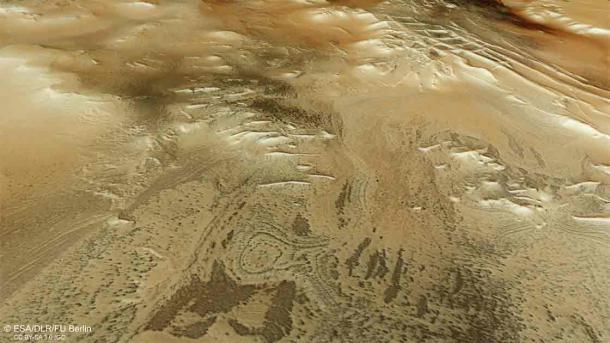🔴 Website 👉 https://u-s-news.com/
Telegram 👉 https://t.me/usnewscom_channel
ESA’s Mars Express has captured images revealing distinctive formations dubbed “spiders” dispersed across the southern polar region of Mars. These features are caused by a fascinating interplay of seasonal changes and geological processes.
During the Martian winter, layers of carbon dioxide accumulate on the surface. Then, with the arrival of spring, sunlight penetrates the surface to cause a transformation.
Solid, Liquid, Gas
The European Space Agency’s Mars Express exploration has found that the bottom layer of carbon dioxide ice transitions directly into gas, exerting pressure and rupturing the overlying ice slabs. As this gas escapes to the surface, it carries dark dust particles, creating towering fountains or geysers that disperse the material across the landscape.
Thousands of the “spiders” can be seen dotting the landscape (European Space Agency / CC-BY-SA 3.0)
The “spiders” observed on Mars are believed to stem from the interaction of sunlight with layers of frozen carbon dioxide on the planet’s surface. Located at Mars’s south pole, where temperatures can plummet as low as –243 degrees Fahrenheit (-152.778 °C) the frigid conditions cause carbon dioxide in the atmosphere to freeze into solid ice.
The ejected dust settles on the surface, forming dark spots ranging from 45 meters (145 feet) to 1 kilometers (0.6 miles) in diameter. These spots serve as indicators of the underlying geological activity. The process also carves intricate spider-shaped patterns beneath the surface enhancing the peculiar landscape.
ESA’s Mars explorers, particularly the ExoMars Trace Gas Orbiter (TGO) in 2020, have provided a detailed glimpse of the intricate spider-like patterns etched across the Martian surface, reports Live Science. In contrast to the Mars Express imagery, which showcases the dark spots resulting from escaping gas and material, the TGO’s perspective unveils the delicate, tendril-like channels carved into the icy terrain below.
An ”Inca City”
These dark spots, visible throughout the Mars Express image, cross rugged hills and expansive plateaus. They are particularly concentrated in a dark close to what has been affectionately dubbed an “Inca City” .
Another view of the Inca City with the rounded layered deposits in the foreground (European Space Agency / CC-BY-SA 3.0)
Here these spots evoke the image of spidery formations amidst a landscape reminiscent of South American Inca ruins. Formally known as Angustus Labyrinthus, Inca City was first identified by NASA’s Mariner 9 probe in 1972.
“We’re still not sure exactly how Inca City formed,” ESA officials said in the statement. “It could be that sand dunes have turned to stone over time. Perhaps material such as magma or sand is seeping through fractured sheets of Martian rock. Or, the ridges could be ‘eskers,’ winding structures related to glaciers.” Captured by Mars Express’s High Resolution Stereo Camera, this new view of Inca City and its cryptic arachnid inhabitants raises questions about the formation of this landscape.
The circular “walls” of Inca City, spanning 86 kilometers (53 miles) in diameter, suggest an origin within a large crater, likely formed by an impacting celestial body. The resulting shockwaves likely propagated through the surrounding plain, subsequently filled by rising lava and gradually eroded over time.
As the patterns move away from this point, the landscape transitions, revealing large, rounded swirls reminiscent of marble. This phenomenon likely arises from the gradual erosion of layered deposits over time.
Next come prominent steep-flanked mounds and hills, towering over 1500 meters (0.9 miles) above the terrain, punctuating the landscape. These formations emerge as softer materials succumb to erosion by wind, water, or ice, leaving behind the resilient material that forms these distinct features.
Moving north from here, the terrain becomes increasingly veiled in smooth, light-colored dust. Despite this, traces of the elusive spiders persist, scattered among various canyons and troughs, adding to the Martian landscape’s mystique.
Over the past two decades and beyond, Mars Express has been an invaluable asset in unraveling the mysteries of the Red Planet. Through its continuous imaging efforts, mineral mapping, atmospheric analysis, subsurface probing, and environmental studies, the orbiter has provided unparalleled insights into Mars’s diverse landscape and dynamic processes.
Equipped with the High-Resolution Stereo Camera (HRSC), Mars Express has unveiled a plethora of Martian features, ranging from wind-carved ridges and grooves to sinkholes nestled on the slopes of towering volcanoes. Its observations have also captured the intricate details of impact craters, tectonic faults, meandering river channels, and ancient lava formations, painting a comprehensive picture of Mars’ geological history and surface evolution.
Top image: No Ziggy? The Inca City at the Martian Pole surrounded by thousands of spiders from Mars, here seen as tiny dark spots. Source: European Space Agency / CC-BY-SA 3.0.
By Sahir Pandey


